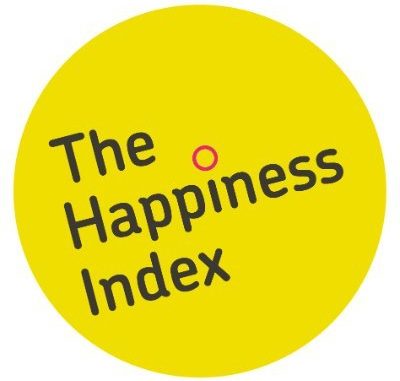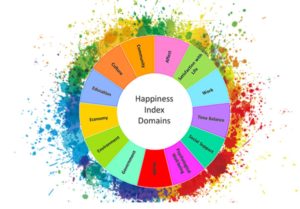
Table of Contents
What is Happiness Index?
- The Happiness Index is a survey that measures your happiness in 10 different areas of our life.
- The Happiness Index is a comprehensive survey instrument that assesses happiness, wellbeing, and aspects of sustainability and resilience.
- Happiness Index is also known as comprehensive measure of wellbeing.
- Happiness index is a happiness measure based on survey data that was first used in the World Happiness Report in 2012.
- The data collected from the survey is used to evaluate the happiness of people.
- The 2018 World Happiness Report defines the Happiness Index (or “Life ladder”) as follows:
“Please imagine a ladder, with steps numbered from 0 at the bottom to 10 at the top. The top of the ladder represents the best possible life for you and the bottom of the ladder represents the worst possible life for you. On which step of the ladder would you say you personally feel you stand at this time?”
This ladder is known as the Cantril Ladder and it is used in a lot of studies as a simple way to ask people to rate their current satisfaction with life – or happiness.
- The Bhutanese Gross National Happiness Index is the source of the Happiness Index’s definition. Bhutan began valuing happiness over other aspects such as riches, comfort, and economic growth in 1972.
- They devised a happiness index based on numerous quantitative elements, and they’ve been tracking it ever since.
- Happiness Index can be used to measure the satisfaction with life and the condition of life.
- Happiness Index is used to define income inequality, trust in government, and sense of community and other aspects of wellbeing within specific demographics of a population.
- The respondents are asked to rate their happiness on a scale of 0 to 10 in the study.
- The Happiness Index is calculated by taking the average of the respondents’ survey results
- The Happiness Index measures life satisfaction, the feeling of happiness, and other happiness domains: psychological well-being, health, time balance, community, social support, education, arts and culture, environment, governance, material well-being, and work
Domains of Happiness
The qualities measured in the domain of happiness are as follows:
- Psychological Well-Being: optimism, senses of purpose and of accomplishment;
- Health: energy level and ability to perform everyday activities;
- Time Balance: enjoyment, feeling rushed, and sense of leisure;
- Community: sense of belonging, volunteerism, and sense of safety;
- Social Support: satisfaction with friends and family, feeling loved, and feeling lonely;
- Education, Arts, and Culture: access to cultural and educational events and diversity;
- Environment: access to nature, pollution, and conservation;
- Governance: trust in government, sense of corruption, and competency;
- Material Well-Being: financial security and meeting basic needs; and
- Work: compensation, autonomy, and productivity. (Happiness Alliance, 2014c)

Background of Happiness Index
- The Happiness Index was first created by the Global Happiness Council, a group of independent academic happiness specialists.
- The definition of the Happiness Index originates from the Bhutanese Gross National Happiness Index.
- The concept of Gross National Happiness (GNH) was developed by the Kingdom of Bhutan in response to pressures to use Gross National Product as the primary goal and metric for the government.
- In 1972, Bhutan started prioritizing happiness over other factors such as wealth, comfort and economic growth. They created an indexation for happiness based on multiple measurable factors, and have kept track of this index ever since.
- In Bhutan, GNH is measured using the GNHI (Gross National Happiness Index).
- In July 2011, the UN General Assembly adopted the resolution Happiness: Towards a Holistic Definition of Development
- Members of the countries were invited to measures the happiness of their people and to use the data to help guide public policy
- In April 2012- the first UN high level meeting called Wellbeing and Happiness: defining a New Economic Paradigm, chaired by the then UN Secretary General Ban Ki-moon and Bhutan’s Prime Minister
- Additionally, Bhutan had adopted Gross National Happiness instead of Gross Domestic Product as their main development indicator
- The first world Happiness report was released in April 1, 2012 that outlined the state of world happiness, causes of happiness and misery and policy implications.
- Since 2016, the report is launched around 20th March to coincide with UN’s International Day of Happiness.
World Happiness Report
- World Happiness Report is compiled by UN Sustainable Development Solutions Network and data collected chiefly from Gallup World Poll
- The Gallup World Poll is used to compile the statistics for the World Happiness Report.
- Gallup, the firm behind this massive survey, interviews about 1,000 people per country every year.
- Gallup conducts interviews with these individuals in more than 160 countries around the world i.e. more than 98% of the adult population are included
- These individuals are chosen at random, as long as they are citizens of the country (non-institutionalized) and aged 15 and up.
- To obtain statistically comparable results, each respondent in this happiness poll is asked the same questions in his or her own language.
- The World Happiness Report is based on this massive amount of data, which is combined with other data sources by the Global Happiness Council
Importance/Use of Happiness Index
- Happiness Index is a tool to assess, understand, and enhance individual’s happiness, community well-being, social justice, economic equality, and environmental sustainability.
- Happiness Index helps to promote social change
- Happiness Index provides necessary data to the researchers and policy makers to plan for the well-being and happiness of the citizens.
The World Happiness Report 2021
Theme: life under COVID-19
- Because of COVID-19, fewer countries could be surveyed- 149 countries
- It focused on COVID-19’s impact on the structure and quality of people’s lives
Rankings of the top 10 countries include:
- Finland (For 4 consecutive years, it ranks 1st)
- Denmark
- Switzerland
- Iceland
- The Netherlands
- Norway
- Sweden
- Luxemburg
- New Zealand
- Austria
Differences between HDI and Happiness Index
| Human Development Index (HDI) | Happiness Index |
| Human Development Index (HDI) is a conceptual approach that does not capture the contentment or psychological state of individuals | Happiness Index is subjective wellbeing, an empirical one that capture the contentment or psychological state of individuals |
| Using the human development lens and metrics can help assess whether genuine progress has occurred if subjective wellbeing has increased | If the (partial) metrics of human development indicate that progress has happened, using the subjective wellbeing lens and metrics can assist determine if progress has occurred |
| Human development indicators are
objective indicators |
The indicators in the happiness index are a combination of subjective and objective evaluations of people’s perception |
| Human development is simply an increase in income and riches. The theories of human capital production and human resource development are found to be inadequate by human development because they see human beings primarily as means rather than purposes | It’s a method of assessing progress that takes into account numerous dimensions and nonmonetary indicators of happiness, emphasizes the value of freedom and opportunity, and understands that people translate their skills into happiness at varying rates |
Relationship between HDI and Happiness Index
- According to an Indian saying, it is better to be blind than to observe things solely from one perspective. Using both can give us a more complete and accurate view of what’s going on.
- At HDI’s core, human growth is a conceptual approach. While advances in human development are desirable by definition, the concept’s breadth makes it impossible to fully assess the level of human development across a society
- On the other hand, while it is possible to quantify changes in subjective well-being across a population, it is impossible to tell how it may be improved without more investigation
- The well-being approach can be utilized to bring new insights into the human development approach since it provides primary data about how people value their own lives
- For example, among the components considered important to the human development approach, the role of the social context, which is central to explanations of subjective well-being, has gotten very little attention thus far
- As a result, the two perspectives on development may complement one another and both should be used to bring overall development in a country
References and For More Information
https://worldhappiness.report/ed/2022/
https://worldhappiness.report/ed/2022/happiness-benevolence-and-trust-during-covid-19-and-beyond/
https://www.happycounts.org/blog/what-is-the-happiness-index
https://survey.happycounts.org/survey/directToSurvey
https://scholarworks.waldenu.edu/cgi/viewcontent.cgi?article=1131&context=jsc
https://www.trackinghappiness.com/happiness-index-2018/
https://s3.amazonaws.com/happiness-report/2018/WHR_web.pdf
http://ictactjournals.in/paper/IJMS_Vol_6_Iss_1_Paper_5_1170_1173.pdf
https://www.researchgate.net/publication/333236662_An_outline_of_Happiness_Index
https://scholarworks.waldenu.edu/cgi/viewcontent.cgi?article=1131&context=jsc
https://worldpopulationreview.com/country-rankings/happiest-countries-in-the-world
https://hdr.undp.org/sites/default/files/happiness_and_hd.pdf
https://worldresearchersassociations.com/mngmntspecialissue/10.pdf
https://scholarworks.uni.edu/cgi/viewcontent.cgi?article=1093&context=mtie